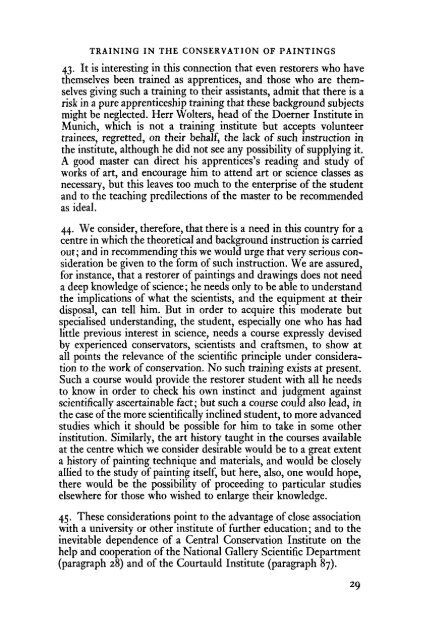Training in the Conservation of Paintings - Calouste Gulbenkian ...
Training in the Conservation of Paintings - Calouste Gulbenkian ...
Training in the Conservation of Paintings - Calouste Gulbenkian ...
Create successful ePaper yourself
Turn your PDF publications into a flip-book with our unique Google optimized e-Paper software.
TRAINING IN THE CONSERVATION OF PAINTINGS<br />
43. It is <strong>in</strong>terest<strong>in</strong>g <strong>in</strong> this connection that even restorers who have<br />
<strong>the</strong>mselves been tra<strong>in</strong>ed as apprentices, and those who are <strong>the</strong>mselves<br />
giv<strong>in</strong>g such a tra<strong>in</strong><strong>in</strong>g to <strong>the</strong>ir assistants, admit that <strong>the</strong>re is a<br />
risk <strong>in</strong> a pure apprenticeship tra<strong>in</strong><strong>in</strong>g that <strong>the</strong>se background subjects<br />
might be neglected. Herr Wolters, head <strong>of</strong> <strong>the</strong> Doerner Institute <strong>in</strong><br />
Munich, which is not a tra<strong>in</strong><strong>in</strong>g <strong>in</strong>stitute but accepts volunteer<br />
tra<strong>in</strong>ees, regretted, on <strong>the</strong>ir behalf, <strong>the</strong> lack <strong>of</strong> such <strong>in</strong>struction <strong>in</strong><br />
<strong>the</strong> <strong>in</strong>stitute, although he did not see any possibility <strong>of</strong> supply<strong>in</strong>g it.<br />
A good master can direct his apprentices's read<strong>in</strong>g and study <strong>of</strong><br />
works <strong>of</strong> art, and encourage him to attend art or science classes as<br />
necessary, but this leaves too much to <strong>the</strong> enterprise <strong>of</strong> <strong>the</strong> student<br />
and to <strong>the</strong> teach<strong>in</strong>g predilections <strong>of</strong> <strong>the</strong> master to be recommended<br />
as ideal.<br />
44. We consider, <strong>the</strong>refore, that <strong>the</strong>re is a need <strong>in</strong> this country for a<br />
centre <strong>in</strong> which <strong>the</strong> <strong>the</strong>oretical and background <strong>in</strong>struction is carried<br />
out; and <strong>in</strong> recommend<strong>in</strong>g this we would urge that very serious consideration<br />
be given to <strong>the</strong> form <strong>of</strong> such <strong>in</strong>struction. We are assured,<br />
for <strong>in</strong>stance, that a restorer <strong>of</strong> pa<strong>in</strong>t<strong>in</strong>gs and draw<strong>in</strong>gs does not need<br />
a deep knowledge <strong>of</strong> science; he needs only to be able to understand<br />
<strong>the</strong> implications <strong>of</strong> what <strong>the</strong> scientists, and <strong>the</strong> equipment at <strong>the</strong>ir<br />
disposal, can tell him. But <strong>in</strong> order to acquire this moderate but<br />
specialised understand<strong>in</strong>g, <strong>the</strong> student, especially one who has had<br />
little previous <strong>in</strong>terest <strong>in</strong> science, needs a course expressly devised<br />
by experienced conservators, scientists and craftsmen, to show at<br />
all po<strong>in</strong>ts <strong>the</strong> relevance <strong>of</strong> <strong>the</strong> scientific pr<strong>in</strong>ciple under consideration<br />
to <strong>the</strong> work <strong>of</strong> conservation. No such tra<strong>in</strong><strong>in</strong>g exists at present.<br />
Such a course would provide <strong>the</strong> restorer student with all he needs<br />
to know <strong>in</strong> order to check his own <strong>in</strong>st<strong>in</strong>ct and judgment aga<strong>in</strong>st<br />
scientifically ascerta<strong>in</strong>able fact; but such a course could also lead, <strong>in</strong><br />
<strong>the</strong> case <strong>of</strong> <strong>the</strong> more scientifically <strong>in</strong>cl<strong>in</strong>ed student, to more advanced<br />
studies which it should be possible for him to take <strong>in</strong> some o<strong>the</strong>r<br />
<strong>in</strong>stitution. Similarly, <strong>the</strong> art history taught <strong>in</strong> <strong>the</strong> courses available<br />
at <strong>the</strong> centre which we consider desirable would be to a great extent<br />
a history <strong>of</strong> pa<strong>in</strong>t<strong>in</strong>g technique and materials, and would be closely<br />
allied to <strong>the</strong> study <strong>of</strong> pa<strong>in</strong>t<strong>in</strong>g itself, but here, also, one would hope,<br />
<strong>the</strong>re would be <strong>the</strong> possibility <strong>of</strong> proceed<strong>in</strong>g to particular studies<br />
elsewhere for those who wished to enlarge <strong>the</strong>ir knowledge.<br />
45. These considerations po<strong>in</strong>t to <strong>the</strong> advantage <strong>of</strong> close association<br />
with a university or o<strong>the</strong>r <strong>in</strong>stitute <strong>of</strong> fur<strong>the</strong>r education; and to <strong>the</strong><br />
<strong>in</strong>evitable dependence <strong>of</strong> a Central <strong>Conservation</strong> Institute on <strong>the</strong><br />
help and cooperation <strong>of</strong> <strong>the</strong> National Gallery Scientific Department<br />
(paragraph 28) and <strong>of</strong> <strong>the</strong> Courtauld Institute (paragraph 87).<br />
29

















